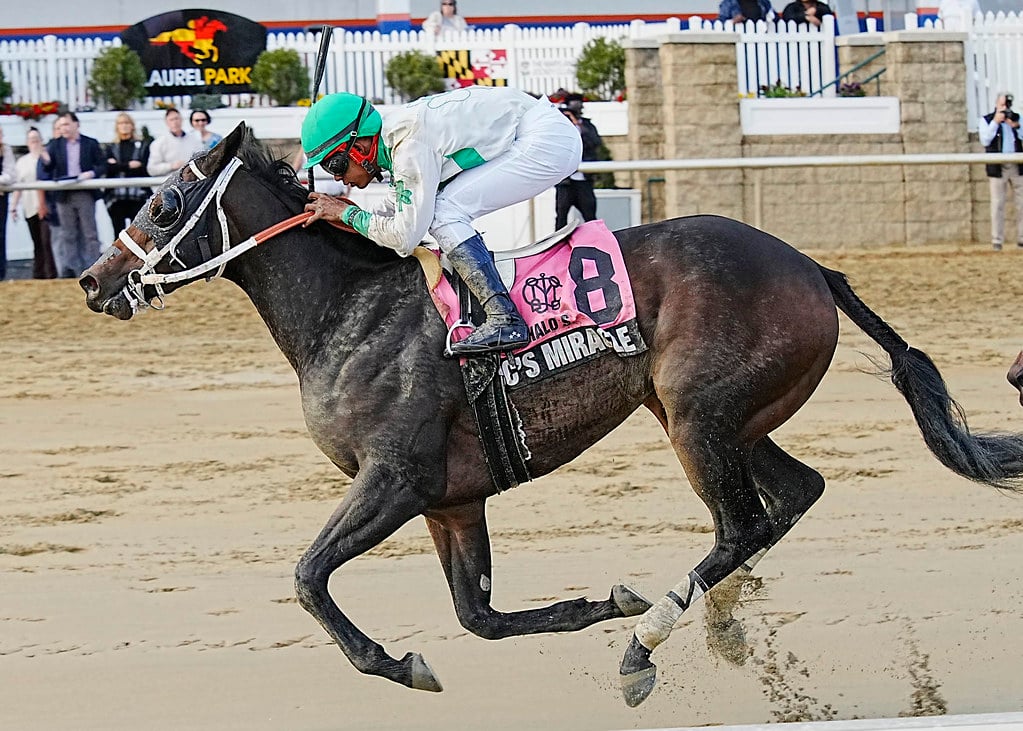[et_pb_section admin_label=”section”][et_pb_row admin_label=”row”][et_pb_column type=”4_4″][et_pb_text admin_label=”Major advertisers” background_layout=”light” text_orientation=”left” use_border_color=”off” border_color=”#ffffff” border_style=”solid” module_id=”Major advertisers”]
Members of the Maryland Racing Commission consider the Struth case. Photo by The Racing Biz.
by Frank Vespe
The Maryland Racing Commission Tuesday decided that the Struth – and the absolute insurer rule – outweighed what it perceived as the truth and Mike Trombetta.
The case, which could have had wide-ranging implications not just in Maryland but across the country, instead simply upholds the sport’s longstanding regulatory scheme.
Struth, trained by Trombetta for Fitzhugh LLC, was disqualified after testing positive for clenbuterol following a second-place finish in allowance company on July 24.
That, said Trombetta, “was very upsetting to me” because he does not use clenbuterol or even keep it in his barn. “I didn’t know how it could be possible,” he said of the positive.
[/et_pb_text][et_pb_text admin_label=”All advertisers” background_layout=”light” text_orientation=”left” use_border_color=”off” border_color=”#ffffff” border_style=”solid”]
Trombetta came to today’s Commission meeting to appeal the disqualification of his trainee and, he said, “to declare my innocence.”
He accomplished the second part of his goal: convincing the Commission that he did not administer or cause to be administered to Struth the clenbuterol that Truesdail Laboratories found in the horse’s system.
What he did not accomplish, however, was to overturn the stewards’ decision disqualifying the horse.
“We truly, honestly believe your testimony,” Commission chairman Michael Algeo told Trombetta in announcing the ruling. “[But] what has been definitively established is this horse had clenbuterol in his system.”
[/et_pb_text][et_pb_text admin_label=”Text” background_layout=”light” text_orientation=”left” use_border_color=”off” border_color=”#ffffff” border_style=”solid”]
[/et_pb_text][et_pb_text admin_label=”2nd part of story” background_layout=”light” text_orientation=”left” use_border_color=”off” border_color=”#ffffff” border_style=”solid”]
And Maryland’s rules state that the trainer is “the absolute insurer of, and responsible for, the condition of each horse the trainer enters in a race, regardless of the acts of third parties.”
Which means, in the Commission’s eyes, it didn’t have much choice.
The final result: Struth will be disqualified from purse money, and Trombetta will be slapped with two multiple medication violation points. The Commission did decide to waive a 15-day suspension the stewards had imposed. The decision was made unanimously by a four-person panel of the Commission, including commissioners Tom Winebrener, Tammy Lafferty, David Hayden, and chairman Michael Algeo.
The case came to the Commission as a result of Trombetta’s appeal of the stewards’ October 4 ruling. In that case, the stewards disqualified Struth from a July 24 race, suspended Trombetta for 15 days, and slapped the trainer with two multiple medication violation points after Struth was found to have clenbuterol in his system in post-race testing.
Clenbuterol, a bronchodilator, is on the state’s list of substances permitted up to a threshold amount; the threshold is 140 picograms per milliliter in urine or the limit of detection – basically, any measurable amount – in blood.
Struth, who finished second in the allowance contest in question, was found to have 136 picograms per milliliter in his blood – well in excess of the limit of detection standard in place. In his urine, however, Struth had just “a few picograms per milliliter,” Commission chief investigator Joe Poag testified he was told by Truesdail.
Clenbuterol is typically found in higher numbers in urine than in blood, making Struth’s situation – the exact opposite of what is typical – unusual. Trombetta’s attorney, Steve Allen, seized on the anomaly to suggest that Struth must have been “environmentally exposed” to the medication sometime between the end of the race, which went off at 4:52 p.m., and the time when blood was drawn, at 5:33.
In the interim period, Struth, like all runners, would have been unsaddled near the Laurel Park paddock, walked to the test barn, cooled out in the test barn, and given water to facilitate urination prior to having blood drawn. He would have been accompanied at each step of his journey by one of Trombetta’s employees.
“This horse was exposed post-race by circumstances not involving Mr. Trombetta,” Allen claimed.
His position was backed up Dr. Kathy Anderson, of Equine Veterinary Care, who is the veterinarian for Trombetta’s Fair Hill string. She said that not only does the trainer not use the drug but that, on infrequent occasions when she has suggested it for a horse with a breathing problem, “he always declines.”
And Dr. Scott Stanley, a professor in the School of Veterinary Medicine at the University of California-Davis, said that in his opinion, the high blood level of clenbuterol, coupled with its low presence in urine, pointed to Allen’s theory.
“This horse either has a small recent exposure, or I can’t explain” the measurements, he said.
The timing matters; had Struth been exposed to clenbuterol – or even had it administered to him – following the race, there would be no cause for disqualification.
But Assistant Attorney General Catherine Bellinger, arguing for the stewards, urged the Commission to focus on two main concepts: that the state’s regulations say that any clenbuterol in the bloodstream past the limit of detection is a positive, and that responsibility for that falls on the trainer’s shoulders.
“What we’re left with is just our regs say level of detection,” she pointed out.
In the end, after a 4 hour 40 minute hearing, the Commission concurred, leaving participants to ponder the absolute insurer rule. Both Trombetta and Allen were quick to call the Commission’s treatment “very fair,” and neither went so far as to call for scrapping the rule.
But Allen called the absolute insurer rule “a very difficult rule to overcome.”
And Trombetta added, “When you throw a big net in the ocean, you catch a lot of different fish. I feel I’m one of the ones that really did no wrong, but yet I’m pulled in.”
“Mr. Trombetta was a very impressive man, and I think the Commission certainly believed him,” Algeo said. “But we are bound by the statute.”
[/et_pb_text][et_pb_text admin_label=”Minor advertisers” background_layout=”light” text_orientation=”left” use_border_color=”off” border_color=”#ffffff” border_style=”solid”]














Craig Milkowski
19th Jan 2017Sir, you might consider reading the following post from Pace Advantage. The author is an expert on the subject. (Not me, to be clear)
http://www.paceadvantage.com/forum/showpost.php?p=2104405&postcount=149
Content below:
“A few interesting things not mentioned or fleshed out in the blog:
(1) Trombetta maintained that he didn’t use clenbuterol nor did he have it in his possession. But that does not mean that he has never used clenbuterol.
When the New York State Racing and Wagering Board implemented stricter regulation of clenbuterol, extended the restriction of use from 4 days out to 14 days:
Mike Trombetta is a Maryland-based trainer who has started 32 horses in New York the last two winters. Since the rules in Maryland and Pennsylvania allow clenbuterol to be given within four days, Trombetta said he will have to be “extremely selective” in what horses he can send to run in New York.
“What is okay practice in most places is now forbidden in New York. I don’t understand what the purpose is.”
(2) Trombetta had a drug violation only a few months before in Pennsylvania. He also had one back in 2008.
(3) While much was made about the defense lawyer’s theory that the horse was exposed to clenbuterol in the few minutes after the running of the race, there is no mention of the equally possible chance that the horse was administered clenbuterol just before the running of his race.
Note the quote from the UC Davis-based Dr. Scott Stanley does not specify timing with respect to the race:
“This horse either has a small recent exposure, or I can’t explain the measurements.”
This does not imply the exact timing of the administration, although the blogger uses the quote to back the opinion of the lawyer.
In fact, small dose raceday administration (given directly in the trachea) of clenbuterol has long been alleged as a common raceday “cheat” at racetracks. The anecdotal evidence for this was so pronounced that there was more than one scientific study done exploring this method of administration.
Furthermore, the exact reason why regulators use a two-pronged threshold (one for blood and one for urine) is in order to identify raceday administration of clenbuterol. In that respect, the laboratory findings are not particularly surprising. A recent exposure is likely to be picked up in blood but not urine.
None of this is to serve as proof that Trombetta was the one who administered clenbuterol to the horse, but all-in-all, this case is not particularly unique unless you buy into the lawyer’s theory.”
The Biz
19th Jan 2017Craig – thanks for sharing. A couple of responses, starting from the premise that one can’t get into every possible iteration of the story in a 1000-word article…
1) We know that Trombetta has used clenbuterol; he admitted as much in the hearing. He says that he has not used it since the rules changed regionally in 2014, and his veterinarians say that is the case.
2) It is true that Trombetta had a positive earlier in ’16 which we didn’t mention; that’s because it doesn’t show up on the main thoroughbred rulings site – in other words, we missed it and we should have referenced it. I’m not sure how relevant an ’08 positive — about 5000 starts ago — is in this circumstance.
3) “Much was made” of the lawyer’s contentions because that’s what drove the hearing. No evidence by either side was offered that the horse was administered clenbuterol just prior to the race, though obviously one could reasonably infer that as a possibility given the short timeframe involved.
Finally, I would suggest that the writer may be an expert in clenbuterol but not in writing a news story, which is what this is. The quotes are used not to back (or oppose) one side or the other, but to amplify the points. The laywer makes a point, and the reporter uses the expert witness’s words to drive it home.
A writer makes editorial decisions about what’s worth including, and what advances the story, and what doesn’t. Does an 8-year-old positive tell us something useful? Does prior use of clenbuterol which has reportedly ceased provide greater context? DIfferent people may arrive at different conclusions on these and many other questions, but the larger point is we were reporting the news, telling the story of how the hearing happened, rather than opining on what should or should not have been done.
Thanks again for weighing in.
Bob Lunny
20th Jan 2017Did anybody investigate how the drug got into his system, or do they just punish because a rule is a rule.
Rules are guidelines, not absolutes.
Basically they took the easy way out. Lazy officials late for lunch and with no intentions of making right